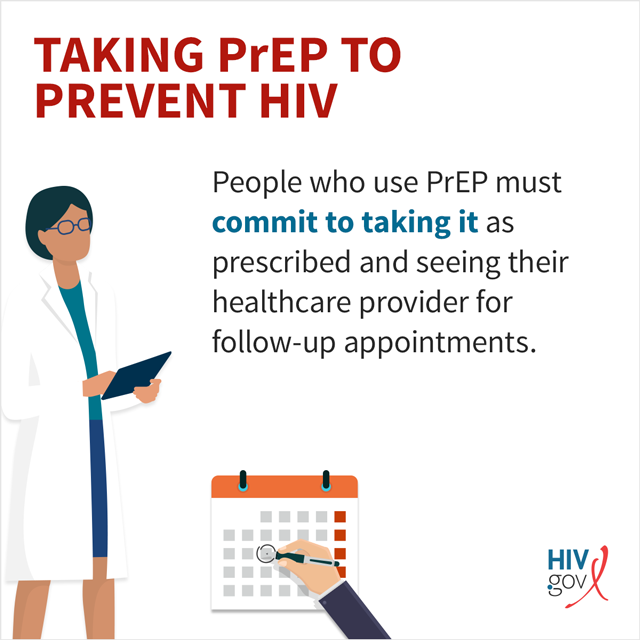Pre-Exposure Prophylaxis
Topics

What is PrEP?
PrEP, or pre-exposure prophylaxis, is medicine people at risk for HIV take to prevent getting HIV from sex or injection drug use. PrEP can stop HIV from taking hold and spreading throughout your body.
Currently, there are two FDA-approved daily oral medications for PrEP. A long-acting injectable form of PrEP has also been approved by the FDA.
Why Take PrEP?
PrEP is highly effective at preventing HIV when taken as indicated.
PrEP reduces the risk of getting HIV from sex by about 99% when taken as prescribed. Among people who inject drugs, it reduces the risk by at least 74% when taken as prescribed. PrEP is much less effective when it isn't taken consistently.
Is PrEP Right for You?
PrEP may benefit you if you test negative for HIV and any of the following apply to you:
- you have had anal or vaginal sex in the past 6 months, and you:
- have a sexual partner with HIV (especially if the partner has an unknown or detectable viral load), or
- have not consistently used a condom, or
- have been diagnosed with an STD in the past 6 months.
Or
- you inject drugs and
- have an injection partner with HIV, or
- share needles, syringes, or other injection equipment.
Or
- you’ve been prescribed PEP (post-exposure prophylaxis) and you
- report continued risk behavior or
- have used multiple courses of PEP
You may choose to take PrEP even if the behaviors above don’t apply to you. Talk to your health care provider.
If you have a partner with HIV and are considering getting pregnant, talk to your doctor about PrEP. PrEP may be an option to help protect you and your baby from getting HIV while you try to get pregnant, during pregnancy, or while breastfeeding.
What Drugs Are Approved for PrEP?
PrEP can be pills or shots.
There are two pills approved for daily use as PrEP. They are combinations of two anti-HIV drugs in a single pill:
- Truvada® (emtricitabine/tenofovir disoproxil fumarate) is for all people at risk for HIV through sex or injection drug use. Generic versionsExit Disclaimer are also available.
- Descovy® (emtricitabine/tenofovir alafenamide) is for sexually active men and transgender women at risk of getting HIV. Descovy® is not for people assigned female at birth who are at risk for HIV through receptive vaginal sex.
A long-acting injectable form of PrEP has also been approved by the FDA:
- Apretude® (cabotegravir) is for people at risk for HIV through sex who weigh at least 77 pounds (35 kg). It’s an injection given by your health care provider every other month instead of daily oral pills.
Is PrEP Safe?
PrEP is safe. No significant health effects have been seen in people who are HIV-negative and have taken PrEP for up to 5 years.
Some people taking PrEP may have side effects, like nausea, diarrhea, headache, fatigue, and stomach pain. These side effects are usually not serious and go away over time. If you are taking PrEP, tell your health care provider if you have any side effect that bothers you or that does not go away.
And be aware: PrEP protects you against HIV but not against other sexually transmitted infections (STIs) or other types of infections. Combining PrEP with condoms will reduce your risk of getting other STIs.
How Do You Get PrEP?

If you think PrEP may be right for you, visit your doctor or health care provider. PrEP is only available by prescription. Any health care provider licensed to write prescriptions can prescribe PrEP; specialization in infectious diseases or HIV medicine is not required.
Because PrEP is for people who are HIV-negative, you’ll have to get an HIV test before starting PrEP and you may need to get other tests to make sure it’s safe for you to use PrEP.
If you take daily oral PrEP, you’ll need to see a health care provider every 3 months for repeat HIV tests, prescription refills, and follow-up. If you use injectable PrEP, you’ll need to see a healthcare provider every two months for an HIV test and the injections.
What If You Don’t Have a Health Care Provider?
If you don’t have a health care provider:
- You can use the HIV Services Locator to find a PrEP provider and other HIV services near you.
- You can visit many community health centers for PrEP services. They have sliding scale fees based on your ability to pay. There are more than 15,000 health centers nationwide. Hundreds of health centers in the 57 jurisdictions prioritized in the Ending the HIV Epidemic initiative are providing PrEP services. Many health centers in other jurisdictions also provide PrEP services.
- Pharmacists can also prescribe PrEP in Arkansas, California, Colorado, Illinois, Maine, Nevada, Oregon, Utah, and Virginia. Read moreExit Disclaimer.
Is PrEP Covered by Insurance?
In most cases, the cost of PrEP medication and services are covered by insurance.
Under the Affordable Care Act, PrEP is free under almost all health insurance plans. PrEP is a preventive service and should be covered without charging you a co-payment or co-insurance. This is true even if you haven’t met your yearly deductible. That means you can’t be charged for your PrEP medication, the clinic visits to see your health care provider, and lab tests you need to get and maintain your prescription. There are no out-of-pocket costs for you. Read moreExit Disclaimer.
This applies to most private health insurance plans you get through your employer or purchase yourself, individual plans you purchase through HealthCare.gov or state-based Marketplaces, and state Medicaid expansion coverage plans, including the Basic Health Plans. In some states, the traditional Medicaid program also covers PrEP at no charge.[1] This does not automatically apply to Medicare. (Medicare Part D prescription drug plans cover PrEP medication, but there will still be cost sharing.)
To find out whether your health plan covers PrEP medications without charge:
- If you have private health insurance through your employer or have purchased it yourself: Check with your health insurance company about coverage for PrEP medications, or look on their drug formulary (drug list) online to find information about coverage for the drugs approved for PrEP.
- If you purchased your health plan through HealthCare.gov or a state-based Marketplace: This NASTAD tip sheetExit Disclaimer can help you verify whether your plan covers PrEP medications.
- If you are on Medicaid: Check with your benefits counselor.
- If you are on Medicare: Find which plans cover your drugs.
- If you are eligible to receive care through the Indian Health Service (IHS): PrEP services are available with no out-of-pocket costs at IHS health centers most tribal health clinics. For more information, visit IHS.gov.
- If you are eligible to receive care from Veterans Programs: PrEP is available for Veterans who use VA for their health care. For information, visit myhealth.VA.gov.
What If You Don’t Have Health Insurance or Still Can’t Afford PrEP?
If you don’t have insurance or Medicaid coverage, there are resources that may be able to help you pay for PrEP and/or your necessary clinic visits and tests.
- If you have private health insurance that doesn’t cover PrEP or still requires a co-payment but you can’t afford it, you may be eligible to receive co-pay assistance from:
- Drug Manufacturers Co-payment Assistance Programs: These are drug manufacturer co-payment assistance programs to help people who have insurance to lower or eliminate the amount they owe as a deductible, co-insurance, and/or co-payment for a specific medication.
- State PrEP Assistance ProgramsExit Disclaimer: California, Colorado, District of Columbia, Illinois, Indiana, Iowa, Massachusetts, New Mexico, Ohio, Oklahoma, and Washington have state-based programs to help people who have insurance to lower or eliminate the amount they owe as a co-payment for PrEP. These programs also support the costs of clinic visits and lab testing.
- Co-payment Assistance Programs for Accessing PrEP via Telemedicine: These are co-payment assistance programs to help individuals who have insurance but can’t afford a co-payment to access providers through telemedicine and have PrEP medication delivered to their homes.
- Patient Advocate FoundationExit Disclaimer: The Patient Advocate Foundation helps people who have insurance to lower or eliminate the amount they owe as a co-payment for PrEP.
- If you do not have health insurance, you may be eligible to receive medication for free from:
- Drug Manufacturers Patient Assistance Programs: These are drug manufacturer patient assistance programs help people who do not have insurance or whose insurance does not cover a specific medication to have access to the medications they need at no or low cost.
- State PrEP Assistance ProgramsExit Disclaimer: California, Colorado, Florida, New Mexico, Oklahoma, Virginia, and Washington have state-based programs to help people who do not have insurance or whose insurance does not cover a specific medication to have access to the medication they need at no cost. These programs also support the costs of clinic visits and lab testing.
- Patient Assistance Programs for Accessing PrEP via Telemedicine: These are patient assistance programs to help individuals who do not have insurance access providers through telemedicine and have PrEP medication delivered to their homes.
- If you are eligible to receive care through the Indian Health Service (IHS): PrEP services are available with no out-of-pocket costs at IHS health centers and most tribal health clinics. For more information, visit IHS.gov.
- If you are eligible to receive care from Veterans Programs: PrEP is available for Veterans who use VA for their health care. For information, visit myhealth.VA.gov.
Learn More About PrEP
If you think PrEP might be right for you, or you want to learn more, visit CDC’s PrEP Basics.
Also: watch and share KFF’s Greater Than HIV and CDC’s Let's Stop HIV Together Ask Me Anything About HIVExit Disclaimer videos with PrEP Basics information and PrEP videos for providersExit Disclaimer. Also, their Powered by PrEP videosExit Disclaimer feature real people sharing why they are taking PrEP to prevent HIV and how it has helped them take charge of their health.
Use the HIV Services Locator to find a PrEP provider and other HIV services near you.
[1] California, Colorado, District of Columbia, Delaware, Hawaii, Iowa, Kentucky, Louisiana, Massachusetts, Montana, Nevada, New Hampshire, New Jersey, Oregon, Washington, and Wisconsin. (NASTAD PrEP Coverage Brief, July 2021Exit Disclaimer (PDF, 205 KB))